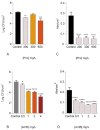Combination of Posaconazole and Amphotericin B in the Treatment of Candida glabrata Biofilms
- PMID: 30518069
- PMCID: PMC6313645
- DOI: 10.3390/microorganisms6040123
Combination of Posaconazole and Amphotericin B in the Treatment of Candida glabrata Biofilms
Abstract
Candidemia cases have been increasing, especially among immunosuppressed patients. Candida glabrata is one of the most resistant Candida species, especially to the azole drugs, resulting in a high demand for therapeutic alternatives. The minimum inhibitory concentration (MIC), minimum fungicidal concentration (MFC), and minimum biofilm eradication concentration (MBEC) were determined for posaconazole (Pcz) and amphotericin B (AmB). The drug combinations of both drugs were evaluated on pre-formed biofilms of C. glabrata ATCC 2001, through XTT (2,3-bis (2-methoxy-4-nitro-5-sulfophenyl)-2H-tetrazolium-5-carboxanilide) assay, colony forming units (CFU), crystal violet, and the fractional inhibitory concentration index (FICI). C. glabrata revealed higher susceptibility and biofilm reduction in the presence of AmB alone, but both drugs revealed a good capacity in the biomass elimination. In the majority of the tested combinations, the interactions were defined as indifferent (FICI ≤ 4). The combination of the two drugs does not seem to bring a clear advantage in the treatment of biofilms of C. glabrata.
Keywords: Candida; Candida glabrata; amphotericin B; antifungal combination; antifungal drug; biofilms; matrix; posaconazole; resistance.
Conflict of interest statement
The authors declare no conflicts of interest.
Figures



Similar articles
-
[Investigation of the correlation between biofilm forming ability of urinary Candida isolates with the use of urinary catheters and change of antifungal susceptibility in the presence of biofilm].Mikrobiyol Bul. 2016 Apr;50(2):256-65. doi: 10.5578/mb.24248. Mikrobiyol Bul. 2016. PMID: 27175498 Turkish.
-
In vitro activity of anidulafungin in combination with amphotericin B or voriconazole against biofilms of five Candida species.J Antimicrob Chemother. 2016 Dec;71(12):3449-3452. doi: 10.1093/jac/dkw316. Epub 2016 Aug 19. J Antimicrob Chemother. 2016. PMID: 27543657
-
In vitro activity of antifungal combinations against Candida albicans biofilms.J Antimicrob Chemother. 2010 Feb;65(2):271-4. doi: 10.1093/jac/dkp429. Epub 2009 Dec 8. J Antimicrob Chemother. 2010. PMID: 19996142
-
Candida and candidaemia. Susceptibility and epidemiology.Dan Med J. 2013 Nov;60(11):B4698. Dan Med J. 2013. PMID: 24192246 Review.
-
Posaconazole: An Update of Its Clinical Use.Pharmacy (Basel). 2015 Oct 21;3(4):210-268. doi: 10.3390/pharmacy3040210. Pharmacy (Basel). 2015. PMID: 28975914 Free PMC article. Review.
Cited by
-
Are Mouthwashes Really Effective against Candida spp.?J Fungi (Basel). 2024 Jul 29;10(8):528. doi: 10.3390/jof10080528. J Fungi (Basel). 2024. PMID: 39194854 Free PMC article. Review.
-
Combination of Farnesol with Common Antifungal Drugs: Inhibitory Effect against Candida Species Isolated from Women with RVVC.Medicina (Kaunas). 2023 Apr 10;59(4):743. doi: 10.3390/medicina59040743. Medicina (Kaunas). 2023. PMID: 37109701 Free PMC article.
-
Characterization of Oral Candida spp. Biofilms in Children and Adults Carriers from Eastern Europe and South America.Antibiotics (Basel). 2023 Apr 22;12(5):797. doi: 10.3390/antibiotics12050797. Antibiotics (Basel). 2023. PMID: 37237699 Free PMC article.
-
Antifungal Susceptibility and Candida sp. Biofilm Production in Clinical Isolates of HIV-Positive Brazilian Patients under HAART Therapy.Biomedicines. 2024 Jan 29;12(2):310. doi: 10.3390/biomedicines12020310. Biomedicines. 2024. PMID: 38397912 Free PMC article.
-
Overview on the Infections Related to Rare Candida Species.Pathogens. 2022 Aug 24;11(9):963. doi: 10.3390/pathogens11090963. Pathogens. 2022. PMID: 36145394 Free PMC article. Review.
References
-
- Pappas P.G., Kauffman C.A., Andes D.R., Clancy C.J., Marr K.A., Ostrosky-Zeichner L., Reboli A.C., Schuster M.G., Vazquez J.A., Walsh T.J., et al. Clinical Practice Guideline for the Management of Candidiasis: 2016 Update by the Infectious Diseases Society of America. Clin. Infect. Dis. 2015;62:e1–e50. doi: 10.1093/cid/civ933. - DOI - PMC - PubMed
Grants and funding
LinkOut - more resources
Full Text Sources
Miscellaneous

